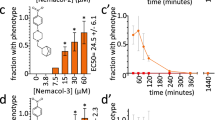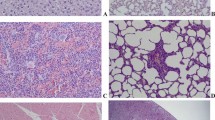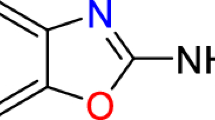Abstract
Anthelmintic resistance in human and animal pathogenic helminths has been spreading in prevalence and severity to a point where multidrug resistance against the three major classes of anthelmintics—the benzimidazoles, imidazothiazoles and macrocyclic lactones—has become a global phenomenon in gastrointestinal nematodes of farm animals. Hence, there is an urgent need for an anthelmintic with a new mode of action. Here we report the discovery of the amino-acetonitrile derivatives (AADs) as a new chemical class of synthetic anthelmintics and describe the development of drug candidates that are efficacious against various species of livestock-pathogenic nematodes. These drug candidates seem to have a novel mode of action involving a unique, nematode-specific clade of acetylcholine receptor subunits. The AADs are well tolerated and of low toxicity to mammals, and overcome existing resistances to the currently available anthelmintics.
This is a preview of subscription content, access via your institution
Access options
Subscribe to this journal
Receive 51 print issues and online access
$199.00 per year
only $3.90 per issue
Buy this article
- Purchase on Springer Link
- Instant access to full article PDF
Prices may be subject to local taxes which are calculated during checkout




Similar content being viewed by others
References
De Clercq, D. et al. Failure of mebendazole in treatment of human hookworm infections in the southern region of Mali. Am. J. Trop. Med. Hyg. 57, 25–30 (1997)
Geerts, S. & Gryseels, B. Drug resistance in human helminths: current situation and lessons from livestock. Clin. Microbiol. Rev. 13, 207–222 (2000)
Awadzi, K. et al. An investigation of persistent microfilaridermias despite multiple treatments with ivermectin, in two onchocerciasis-endemic foci in Ghana. Ann. Trop. Med. Parasitol. 98, 231–249 (2004)
Osei-Atweneboana, M. Y., Eng, J. K., Boakye, D. A., Gyapong, J. O. & Prichard, R. K. Prevalence and intensity of Onchocerca volvulus infection and efficacy of ivermectin in endemic communities in Ghana: a two-phase epidemiological study. Lancet 369, 2021–2029 (2007)
Waller, P. J. Anthelmintic resistance. Vet. Parasitol. 72, 391–412 (1997)
Jackson, F. & Coop, R. L. The development of anthelmintic resistance in sheep nematodes. Parasitology 120 (suppl.). S95–S107 (2000)
Kaplan, R. M. Drug resistance in nematodes of veterinary importance: a status report. Trends Parasitol. 20, 477–481 (2004)
Besier, B. New anthelmintics for livestock: the time is right. Trends Parasitol. 23, 21–24 (2007)
Wolstenholme, A. J., Fairweather, I., Prichard, R., von Samson-Himmelstjerna, G. & Sangster, N. C. Drug resistance in veterinary helminths. Trends Parasitol. 20, 469–476 (2004)
Ruaud, A. F. & Bessereau, J. L. Activation of nicotinic receptors uncouples a developmental timer from the molting timer in Caenorhabditis elegans. Development 133, 2211–2222 (2006)
Rand, J. B. Acetylcholine. In WormBook (ed. The C. elegans Research Community) 10.1895/wormbook.1.131 1 〈http://www.wormbook.org〉 (30 January 2007)
Fleming, J. T. et al. Caenorhabditis elegans levamisole resistance genes lev-1, unc-29, and unc-38 encode functional nicotinic acetylcholine receptor subunits. J. Neurosci. 17, 5843–5857 (1997)
Culetto, E. et al. The Caenorhabditis elegans unc-63 gene encodes a levamisole-sensitive nicotinic acetylcholine receptor α subunit. J. Biol. Chem. 279, 42476–42483 (2004)
Mongan, N. P., Jones, A. K., Smith, G. R., Sansom, M. S. & Sattelle, D. B. Novel α7-like nicotinic acetylcholine receptor subunits in the nematode Caenorhabditis elegans. Protein Sci. 11, 1162–1171 (2002)
Treinin, M., Gillo, B., Liebman, L. & Chalfie, M. Two functionally dependent acetylcholine subunits are encoded in a single Caenorhabditis elegans operon. Proc. Natl Acad. Sci. USA 95, 15492–15495 (1998)
Wood, I. B. et al. World Association for the Advancement of Veterinary Parasitology (W.A.A.V.P.) second edition of guidelines for evaluating the efficacy of anthelmintics in ruminants (bovine, ovine, caprine). Vet. Parasitol. 58, 181–213 (1995)
Boisvenue, R. J., Brandt, M. C., Galloway, R. B. & Hendrix, J. C. In vitro activity of various anthelmintic compounds against Haemonchus contortus larvae. Vet. Parasitol. 13, 341–347 (1983)
Anderson, P. Mutagenesis. Methods Cell Biol. 48, 31–58 (1995)
Wicks, S. R., Yeh, R. T., Gish, W. R., Waterston, R. H. & Plasterk, R. H. Rapid gene mapping in Caenorhabditis elegans using a high density polymorphism map. Nature Genet. 28, 160–164 (2001)
van Wyk, J. A. & Malan, F. S. Resistance of field strains of Haemonchus contortus to ivermectin, closantel, rafoxanide and the benzimidazoles in South Africa. Vet. Rec. 123, 226–228 (1988)
Bendtsen, J. D., Nielsen, H., von Heijne, G. & Brunak, S. Improved prediction of signal peptides: SignalP 3.0. J. Mol. Biol. 340, 783–795 (2004)
Thompson, J. D., Higgins, D. G. & Gibson, T. J. CLUSTAL W: improving the sensitivity of progressive multiple sequence alignment through sequence weighting, position-specific gap penalties and weight matrix choice. Nucleic Acids Res. 22, 4673–4680 (1994)
Jones, A. K., Davis, P., Hodgkin, J. & Sattelle, D. B. The nicotinic acetylcholine receptor gene family of the nematode Caenorhabditis elegans: an update on nomenclature. Invert. Neurosci. 7, 129–131 (2007)
Acknowledgements
We thank F. Schroeder, E. Pradervand, S. Mulhauser, J. Lambert, D. Mosimann and A. Kazimi for technical assistance; C. Johnson for providing an ivermectin-resistant C. elegans strain; and C. Kempter for support on chemical characterization of AADs. We also thank S. Nanchen, B. Hosking, A. Redpath and R. Steiger for thorough review of and comments on the manuscript. P.M. is supported by the Swiss National Science Foundation.
Author information
Authors and Affiliations
Corresponding author
Ethics declarations
Competing interests
The value of patent WO2002049641 may be affected by publication of the article. Concerning pending patent applications, the authors declare that they are bound by confidentiality agreements that prevent them from disclosing their financial interest in this work.
Supplementary information
Supplementary Information
The file contains Supplementary Methods with details on the chemical synthesis of amino-acetonitrile derivatives (AADs); Supplementary Data with chiral resolution of AAD-1470 and biological activity of the enantiomers; Supplementary Figures S1-S2 illustrating NMR spectra of AADs (Figure S1) and multiple alignment of nicotinic acetylcholine receptor alpha-subunits (Figure S2); and Supplementary Tables S1-S3 with pharmacological (Tables S1 and S3) and genetic (Table S2) data of Caenorhabditis elegans mutants. (PDF 698 kb)
Rights and permissions
About this article
Cite this article
Kaminsky, R., Ducray, P., Jung, M. et al. A new class of anthelmintics effective against drug-resistant nematodes. Nature 452, 176–180 (2008). https://doi.org/10.1038/nature06722
Received:
Accepted:
Issue Date:
DOI: https://doi.org/10.1038/nature06722
This article is cited by
-
Photodegradation of anthelmintic drugs under natural sunlight and simulated irradiation: kinetics, mechanisms, transformation products, and toxicity
Environmental Science and Pollution Research (2024)
-
Anthelmintic efficacy evaluation and mechanism of N-methylbenzo[d]oxazol-2-amine
Scientific Reports (2023)
-
Selective control of parasitic nematodes using bioactivated nematicides
Nature (2023)
-
Benzimidazole and aminoalcohol derivatives show in vitro anthelmintic activity against Trichuris muris and Heligmosomoides polygyrus
Parasites & Vectors (2022)
-
Polymorphisms in exon 11 of the mptl-1 gene and monepantel resistance in Haemonchus contortus
Parasitology Research (2022)
Comments
By submitting a comment you agree to abide by our Terms and Community Guidelines. If you find something abusive or that does not comply with our terms or guidelines please flag it as inappropriate.



